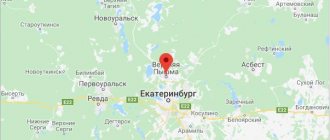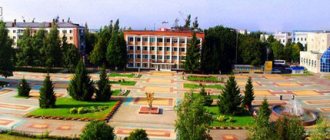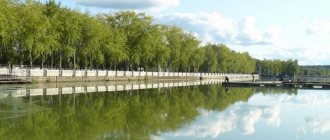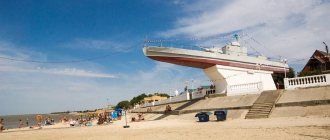- Reports and messages
- Miscellaneous
- Kirov city
In the valley of the Vyatka River stands the city of Kirov.
It is surrounded by the greenery of taiga forests of the European part of the Russian plain. The river divides the city into two parts: the main one and the one beyond the river. The city is the administrative center of the Kirov region. The townspeople call it Vyatka. In the old days it was called Khlynov and changed it three times. Climate
The climate in Kirov is temperate continental. It can be called a northern city. Winter begins in October and ends in spring. At the same time, the temperature does not rise above + 15 degrees C, it rains and thunderstorms thunder.
City `s history
The city has a long history, which begins with the Novgorodians who founded the city in the 12th century. It was renamed several times. Russian chronicles describe the events of centuries from which the history of the city is formed. This is the creation of the Union of Suzdal Princes, and the formation by decree of Catherine II of the Vyatka province with the coat of arms of the city of Vyatka, also in the thirteenth century the Slavs fled here from the Tatar-Mongol yoke. The taiga region saved them from slavery. and many other historical events. The city has gone through a lot, but it stands like a cliff on seven hills and lives on. In the 19th century, in memory of Sergei Mironovich Kirov, the city was named after him.
City residents
More than six hundred thousand people of different nationalities live in the city: Russians, Tatars, Udmurts, Belarusians, Azerbaijanis, Armenians and others.
Industry
Factories and industrial enterprises known not only in Russia operate in Kirov: the Sobol fur factory; dairy plant, March 8 embroidery factory, Volgo-Vyatka Machine Tool Plant, shoe factory, Kirov Boiler Equipment Plant and other enterprises.
Folk crafts
The city of Kirov is famous for its folk crafts, which have lived and operated in the city for more than four centuries. The Dymkovo toy is known far beyond the borders of the Russian Federation. Delicate Vyatka lace with complex weaving elements deserves great attention. The crafts have not lost their relevance today.
Attractions
Kirov has many attractions and cultural sites: churches, cathedrals, temples, monuments and ancient mansions. In the thicket of the forest on the shore of the lake is located the “Fairy Tale Reserve”, adults and children visit the interactive park with fairy-tale characters with great interest:
- at the dacha of Santa Claus;
- with a kikimora in a hut;
- in the knight's fortress;
- on the slides.
Here they play and overcome all difficulties with all the fairy-tale heroes, and of course win.
Kirov is a regional center, here you can get education at nine universities in various specialties. For citizens this is the best city!
Option No. 2
The city of Kirov is located in the northeast of the European part of the Russian Federation in the valley of the Vyatka River. It is a major railway junction; a federal highway runs near the city. The city is rich in the number of famous people living and born in it: M. Saltykov-Shchedrin, A. Green, A. Herzen, K. Tsiolkovsky, P. Tchaikovsky and many other outstanding personalities.
History of the city
The first mentions of the city date back to the 12th century, when Russian settlers discovered these lands. Initially, the city was called Khlynovo in honor of the small river Khlynovka. For the right to own the city, battles were fought between Nizhny Novgorod residents, Ustyuzhans, Muscovites and Tatars. In the 15th century it was renamed Vyatka. In 1934, its modern name was assigned.
During the Great Patriotic War, all industrial factories and weapons were transferred to the city, and civilians also came here for shelter.
Population and national composition
As of 2021, there are about 513 thousand people. Among the nationalities in the region as a whole, Russians predominate - 92%, Tatars - 3%, followed by Maris - 2%, Udmurts - 1%, Ukrainians - 1%, Azerbaijanis - 1%. The bulk of the population - about 74% - lives in the city.
Economic situation in the city
The main economic structures in which the region specializes:
- metalworking,
- mechanical engineering,
- woodworking,
- petrochemical industry,
- production of building materials.
The Kirov region is rich in limestone rocks, clay, phosphorite deposits, and peat reserves.
There are many different factories and enterprises operating in the city: an electrical machine-building plant, a machine-building enterprise, a plant for the production of aircraft missile casings, mines and shells, a tire plant, a non-ferrous metals processing plant.
The city's attractions
Some of the most popular attractions of Kirov are: the Vyatka Folk Arts Museum, the Stone rock massif, the Alexander Garden, the Kirov Puppet Theater, the Vyatka Philharmonic, and the Musical Square.
Also in the Zarechensky district of the city there is a factory for the production of the famous traditional “Dymkovo” molded toys. Products are still produced by hand sculpting, from kneading the material consisting of clay to painting it.
Coat of arms
The coat of arms in its modern form was adopted in 2008. The heraldic symbol - a bow with an arrow superimposed on it - has been known since 1497. Under Ivan IV the Terrible, the sign was placed on the large sovereign seal. Since 1626, a hand in armor holding an arrow has been added to the sign, which first appeared in the Vyatka coat of arms woven on the garden cover (quiver) of Tsar Alexei Mikhailovich. In 1672, a scarlet (red) cross was added to the upper part of the Vyatka coat of arms. In 2008, the coat of arms was restored by Evgeny Drogov and Galina Pozdnyakova, and on August 27, by decision of the Kirov City Duma, it was approved as a symbol of the city of Kirov.
Popular message topics
- Athletics
This sport is included in the list of Olympic Games. Athletics include running, walking, all-around and some technical disciplines. Athletics is considered the most widespread sport. In this sport, athletes are always - City of Vladivostok
In 1860, the history of the city of Vladivostok began. He grew up from a barracks built on the shore of the Golden Horn Bay. At that time, this area was famous for hunting, and the streets were given their names for a reason, but from the events that took place there. - Tea
Tea (translated from Chinese “cha”, from the Beijing and Guangdian dialects - “te”) is a drink obtained by boiling, brewing or infusing tea tree leaves. The tea tree leaf undergoes special treatment before use.
Where does Vyatka begin? How, by whom and why our city was founded
When we talk about history, especially the history of our native land, people and civilization, we always have to start somewhere. Where is that very turning point in the historical chronicle from which we begin our countdown? From what moment did the Vyatka land truly become Vyatka? To answer this question one has to ask many other questions, such as by whom and why.
Novgorod, or Veliky Novgorod, is generally considered the cradle of ancient Russian statehood. The first date that is proposed to be memorized in preparation for school exams on the history of Russia is the year 862, the moment of the calling of the legendary figure Rurik to Novgorod, who is the ancestor of the first royal dynasty in Ancient Rus'. Since then, Novgorod has been consolidated in the public and political consciousness as one of the key centers of early Rus', a place of trade, religion and culture.
Over the next hundreds of years the city grew in influence. It changed and acquired its own unique look and form, and by 1136, passions between the urban boyar elites and the local trading population led to the expulsion of Prince Vsevolod Mstislavich, which in turn marked the beginning of the formation of a unique veche republic. A more democratic form of government in Novgorod led to the formation of a civic mindset that was more free and prone to deviant acts. It is not surprising that this resulted in such a phenomenon as the ushkuiniki - a group of free armed people engaged in river piracy and trade, which was equipped, among other things, at the expense of the Novgorod boyars.
The main target of the Novgorod Ushkuin raids were neighboring peoples and states - the Swedes, Volga Bulgars, Tatars, Mari and Udmurts. It was the raids towards the latter that gave rise to the development of lands near the Vyatka River. According to such a literary monument as “The Tale of the Vyatka Country” (it is important to emphasize that historians still cannot agree on the reliability of the information presented there), in the 12th century (estimated date 1181) they captured settlements such as Bolvan and Koksharov (now known as the village of Nikulchevo and the city of Kotelnich), which gave rise to the settlement of the Vyatka land by the Novgorod Slavs.
According to the most reliable data (Resurrection Chronicle - 16th century), in 1374 a detachment of ushkuiniks numbering 2,500 people made a very successful descent along the rivers and robbed the city of Bulgar (the capital of Volga Bulgaria), after which it was divided into two parts, the first goes deeper into the Tatar lands, for further enrichment, when the second one goes north and stopped at the confluence of the Khlynovka River and the Vyatka River. They discovered a very convenient territory, a natural hill (the modern territory of the embankment and the Eternal Flame), which they decided to strengthen and build their settlement on it for permanent parking, wintering and storing loot. The location was not chosen by chance, since according to medieval tradition, it was in such areas that fortresses were usually built - the terrain features greatly facilitated the efforts to defend the city.
Historians are inclined to believe that the city was first named Vyatka, although later it changed its name to Khlynov, but this is not certain, since it is not excluded that at first it could have had two names. Regarding the origin of the name itself, the most likely version is that Vyatka received it from the Udmurt tribe Vatka, which inhabited the surrounding territories. If we talk about the origin of the name Khlynov, then there is also no definite answer; there is an opinion that the name was derived from an already known river, and there is another that it came from the ancient word “khlyn” (i.e. deceiver), which correlates with the robber origin of the city.
The Novgorod order, including the traditions of self-government, became the basis for the new settlement, on the basis of which such an independent way of life developed. Novgorod included our city as part of “their” lands, trade was carried out, but in general the city was independent and independent, it formed its own boyars and veche, the residents of Vyatka elected a “vataman” (this is exactly how the word ataman was used) - a military leader.
In 1489, however, this way of life came to an end when, during the period of centralization of Rus', the army of Ivan III, numbering 64 thousand people, came to the walls of the Khlynovo Kremlin and demanded submission. Capitulation was inevitable, and many local boyars were either exiled to Moscow or executed. It was after the Veche was liquidated and a Moscow governor was appointed at the head of the city that Vyatka officially became part of the ancient Russian state.
As for what is happening now, the situation is curious. Both in territory and in population, Kirov is much larger than its parent Veliky Novgorod, but one cannot help but notice slight similarities in both cities, in their spirit and culture. And since history does not stand still, the future appearance of these cities depends on us.
The editors of the Internet portal Kirov.ru express special gratitude in compiling this material to the city of Veliky Novgorod itself, which hospitably hosted us as part of a trip to the “Silver Necklace of Russia,” and to the Kirov Regional Museum of Local Lore, which shared with us the history of our city.
History in the Middle Ages
In 1378, an alliance agreement was concluded between the Vyatchans and the Suzdal-Nizhny Novgorod principality, and from 1391 the city became the main residence of the Suzdal princes Vasily Kirdyapa and Semyon Dmitrievich, expelled from the Suzdal-Nizhny Novgorod principality after its conquest by Moscow. After the death of the princes in 1401, power passed to the Galician prince Yuri Dmitrievich. Detachments of Vyatchan people took part in campaigns against the Golden Horde in 1392 and 1409 and in the war of Moscow Prince Vasily I with Novgorod in 1417-1418.
In 1412, the famous battle took place between the Vyatchans and Ustyuzhans. The battle took place at night, in a ravine, later named Razderikhinsky. According to one version, the Ustyun residents came to the aid of the Vyatchans to defend themselves from the Tatars; according to another, they, in alliance with the Moscow princes, wanted to capture the city. In memory of those events, the Vyatka folk festival “Whiplash” appeared, and a chapel in the name of the Archangel Michael was built on the bank of the ravine.
In 1432-1453, Vyatka took part in the war between the Galician and Moscow princes. After the defeat of the Galician group, it came under the control of local boyars and merchants. In 1455-1457, a wooden Kremlin was built in the city, named Khlynov. After two military campaigns of the Moscow army against Khlynov in 1457 and 1459, power in the city formally passed to Moscow, but with the preservation of local self-government. The Khlynovites took part in the military campaigns of the Moscow principality against Novgorod and Kazan.
Joining the Moscow Principality
In the early 80s, power in the city passed to the separatists led by Ioann Anikeev. Under Khan Ibrahim, the Kazan governor sat in Khlynov. Khlynov's troops carried out campaigns against lands under the rule of the Moscow principality. After two unsuccessful attempts, the Moscow army managed to capture the city in 1489. The local nobility was resettled in the Moscow region, and a Moscow governor was installed in the city. The Vyatka land was finally included in the Moscow state.
Due to its remoteness from the main Russian lands, the Vyatka land did not need an alliance with strong principalities and recognized only the patronage of the princes, remaining a self-governing territory. The people's council acted as the main governing body. The most influential group of the feudal class were the boyars, followed by the merchants and the clergy. The rest of the Vyatchans represented a free communal population and consisted of peasants and artisans.
In 1551-1552, Khlynov’s troops took part in Ivan the Terrible’s campaign against the Kazan Tatars. In 1554 and 1556 they took part in campaigns against the Astrakhan Khanate. As a result of these campaigns, Khlynov was returned to his ancestral lands, previously seized by the Golden Horde and then by the Tatar khanates. On June 2, 1580, Khlynov received from Ivan the Terrible a charter to build a monastery in the city, named in honor of the founding abbot Trifonov.
Development of Orthodoxy and trade in Vyatka
In 1607, the first fair in the Vyatka land was organized in the city, called Semyonovskaya, dedicated to September 1. In 1658, the Vyatka and Great Perm diocese was founded with its center in the city of Khlynov. From 1680 to 1686, the governor in the city was the royal steward Kuzma Osipovich Grushetsky, cousin of Queen Agafya Grushetskaya. In 1689, the Assumption Cathedral of the Trifonov Monastery was built - one of the first stone buildings in Khlynov. In 1694, the Khlynovo merchant Spiridon Lyanguzov led the first trade caravan from Moscow to China after the conclusion of a Russian-Chinese treaty that allowed mutual trade.











